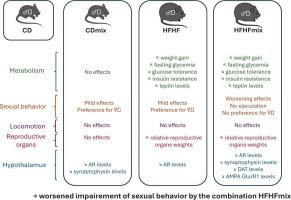雄性小鼠的性行为受到致肥性糖尿病饮食的损害,并因暴露于相关的邻苯二甲酸盐混合物环境而恶化
IF 9.7
1区 环境科学与生态学
Q1 ENVIRONMENTAL SCIENCES
引用次数: 0
摘要
自20世纪初以来,西方国家男性生育能力的下降可能与饮食的变化和工业分子的暴露有关,比如内分泌干扰物,其中包括邻苯二甲酸盐。本研究评估了高脂肪/高果糖饮食(HFHF)和暴露于邻苯二甲酸盐混合物环境(mix)对雄性小鼠性行为的综合影响。四组成年雄性C57Bl/6J小鼠分别饲喂对照饲粮(CD)、对照饲粮与混合物(CDmix)、HFHF饲粮和HFHF饲粮与混合物(HFHFmix)。两种HFHF饮食都引起了代谢改变,但只有HFHFmix饮食改变了性行为的效率,达到射精的动物数量急剧减少,随后交配潜伏期增加。这与睾丸、精子腺和泰森腺重量的减少以及嗅觉偏好测试中对女性同类的歧视减少有关。没有记录到对运动活动的影响。在HFHFmix组,被称为性行为调节通路的突触素、多巴胺转运蛋白(DAT)和谷氨酸受体AMPA GluR1的蛋白量在下丘脑内侧视前区被改变,这是控制性行为的主要整合中心。因此,HFHF饮食和邻苯二甲酸盐对男性性行为的额外影响(剂量与人类接触有关)可以通过该神经网络的改变来解释,从而揭示了需要在公共卫生建议方面特别注意的特定脆弱性。本文章由计算机程序翻译,如有差异,请以英文原文为准。

Sexual behavior in male mice is impaired by an obesogenic-diabetogenic diet and worsened by exposure to a relevant environmental mixture of phthalates
The decrease in male fertility observed since the beginning of the 20th century in Western countries could be linked to changes in diets and exposure to molecules from industry, such as endocrine disruptors and, among them, phthalates. The combined effects of a high fat/high fructose diet (HFHF) and exposure to an environmental mixture of phthalates (mix) were evaluated on male murine sexual behavior. Four groups of adult male C57Bl/6J mice were exposed to a control diet (CD), a control diet coupled with the mix (CDmix), an HFHF diet, and an HFHF diet coupled with the mix (HFHFmix). Both HFHF diets induced metabolic alterations but only the HFHFmix diet altered the efficiency of sexual behavior, with a dramatic decrease in the number of animals reaching ejaculation and a subsequent increase in mating latency. This was associated with a decrease in testicular, seminal glands and Tyson glands weights and a loss in discrimination toward female counterparts in an olfactory preference test. No effects were recorded on locomotion activity. In the HFHFmix group, the protein amounts of synaptophysin, dopamine transporter (DAT), and glutamate receptor AMPA GluR1, known as modulatory pathways of sexual behavior, were modified in the hypothalamic medial preoptic area, the main integrating center in the control of this behavior. The additional effect of an HFHF diet and phthalates, at doses relevant for human exposure, on male sexual behavior, could be thus explained by an alteration in this neural network, revealing a specific vulnerability that requires special attention in term of public health recommendations.
求助全文
通过发布文献求助,成功后即可免费获取论文全文。
去求助
来源期刊

Environment International
环境科学-环境科学
CiteScore
21.90
自引率
3.40%
发文量
734
审稿时长
2.8 months
期刊介绍:
Environmental Health publishes manuscripts focusing on critical aspects of environmental and occupational medicine, including studies in toxicology and epidemiology, to illuminate the human health implications of exposure to environmental hazards. The journal adopts an open-access model and practices open peer review.
It caters to scientists and practitioners across all environmental science domains, directly or indirectly impacting human health and well-being. With a commitment to enhancing the prevention of environmentally-related health risks, Environmental Health serves as a public health journal for the community and scientists engaged in matters of public health significance concerning the environment.
 求助内容:
求助内容: 应助结果提醒方式:
应助结果提醒方式:


